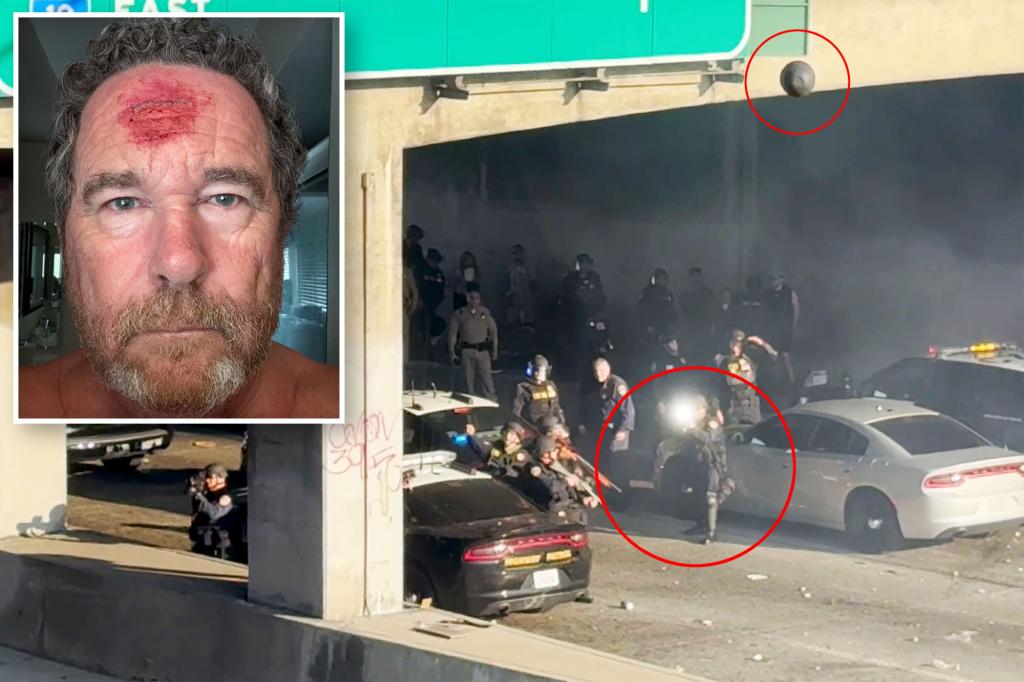Captured Chaos: Photographer Injured by Rubber Bullet During LA Anti-ICE Protests
In a shocking incident that highlights the escalating tensions surrounding immigration enforcement in the United States, a photographer was shot in the head with a rubber bullet while documenting the fiery anti-ICE protests in Los Angeles. This harrowing moment, captured on camera, not only underscores the violence that can erupt during demonstrations but also raises significant questions about the role of law enforcement in managing civil unrest.
The Incident
On a day that began with peaceful demonstrations, chaos ensued as protesters gathered to voice their opposition against ICE (U.S. Immigration and Customs Enforcement). The photographer, who had been covering the event for a local news outlet, was positioned near the front lines, capturing images of the crowd and their passionate chants. However, as tensions escalated, officers employed crowd control measures, which included the use of rubber bullets.
The moment the bullet struck the photographer was caught on camera, providing a visceral reminder of the dangers faced by those in the field. Eyewitness accounts describe the scene as chaotic, with protesters clashing with police, smoke from flares filling the air, and an overwhelming sense of urgency.
The Wider Context of Protests
To understand the gravity of this incident, one must consider the broader context of anti-ICE protests across the nation. These demonstrations have surged in response to the Trump administration’s aggressive immigration policies, characterized by family separations at the border, detentions, and deportations. Activists argue that ICE’s actions are inhumane and call for the agency’s abolition.
- Growth in Activism: The protests in Los Angeles are part of a larger national movement that has gained momentum in recent years, particularly after high-profile incidents involving immigration enforcement.
- Community Response: Local communities, particularly those with large immigrant populations, have rallied together to oppose what they view as unjust policies that threaten their families and livelihoods.
- Media Coverage: As tensions rise, the role of the media becomes increasingly critical. Journalists and photographers are often on the front lines, documenting events that shape public perception and policy.
The Impact of Police Tactics
The use of rubber bullets to disperse crowds raises significant questions about police tactics and the treatment of protesters. Critics argue that such measures can escalate violence rather than quell it, as evidenced by the injury sustained by the photographer. The incident brings to light the need for law enforcement agencies to reassess their crowd control strategies, particularly in the context of peaceful protests.
According to recent studies, the use of less-lethal weapons like rubber bullets can cause severe injuries, and there have been calls from civil rights organizations to ban their use altogether. Advocates argue that police should prioritize de-escalation techniques over forceful measures.
Ethics of Journalism in Conflict
This incident also raises ethical questions about the role of journalists in conflict situations. Photographers and reporters often place themselves in harm’s way to provide coverage of events that are crucial to public discourse. The injury to the photographer serves as a stark reminder of the risks involved in this line of work, particularly in volatile situations like protests.
Media organizations are urged to implement safety protocols to protect their staff, ensuring that journalists can report on crucial issues without endangering their lives. Furthermore, the incident underscores the importance of responsible journalism that provides context and nuance in reporting on complex issues such as immigration.
The Future of Immigration Protests
Looking ahead, the anti-ICE protests are likely to continue, fueled by ongoing immigration debates and policies that impact thousands of families across the country. As public sentiment shifts, the role of protests in shaping policy and societal attitudes towards immigration will remain significant.
- Potential for Change: Increased activism could lead to legislative changes at both the state and federal levels, as lawmakers respond to constituents’ concerns about immigration enforcement.
- Community Mobilization: Grassroots organizations are expected to play a crucial role in mobilizing communities and sustaining momentum for the movement.
- Continued Media Scrutiny: As events unfold, the media will continue to play a pivotal role in documenting protests and providing a platform for voices advocating for change.
Conclusion
The injury of the photographer during the anti-ICE protests in Los Angeles serves as a microcosm of the larger struggles surrounding immigration policy and civil rights in the United States. As tensions continue to rise, it is imperative for all stakeholders—law enforcement, activists, and the media—to engage in open dialogue and reconsider their roles in fostering a society that respects human rights and the dignity of all individuals.
See more CNN Headline


